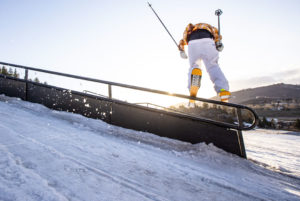
Toting your new powder skis across the country these days is a breeze. With new padded designs to protect your freshly waxed skis or snowboard and perfectly placed pockets for your snowboarding helmet, boots, bindings and accessories, you can check your baggage worry-free. If you’re heading to the mountains on the weekends via car, there are plenty of styles that will keep your jackets, fleece and other accessories organized and away from dirty boots. The House is fully stocked with countless ski bags and snowboard bags in a range of sizes, features, prints and colors. Bag material, zippers, padding, straps and handles, stitching, durability and wheels all come into play. Before we get into more detail about bag specifics, consider the questions below…
- Will you be using the bag every weekend?
- Will your skis and boots get thrown into the car or on top of the car?
- Will you be carrying one pair of skis/snowboard or two?
- Do you plan on taking your skis or snowboard on an airplane?
Padded vs. Unpadded
A padded bag typically has 5mm to 10mm of closed cell polypropylene foam in certain areas of the bag to add durability and protection. They run just beyond the entire length of the skis or snowboard. In some ski or snowboard bags there is only light padding added to make sure that the ski/snowboard bindings don’t puncture the fabric should they drop on the pavement by the airline baggage crew. Many ski bags designed to carry two pairs, there is a padded divider in the middle that prevents the two pairs from clanking together. Price does matter. A higher price usually does yield more padding, pocketing, features and better zippers. Although it is a personal choice, padded bags aren’t essential for weekend car trips. For airline travel, however, padding is definitely recommended. Keep in mind that many padded ski and snowboard bags will not fit in a rooftop carrier. Read Snowbard Bag Review: Burton Wheelie Gig Snowboard Bag
Unpadded bags also have their cons. They cost less than padding and for some people, it’s all that is necessary to protect their skis or snowboard. You can certainly check an unpadded bag on an airplane, but it is highly recommended to generously ‘pad’ your gear with your jacket, snow pants, fleece and other gear. Unpadded bags are also great for weekend car trips, whether your skis or snowboard are going in the back of your SUV or in a roof system. Some people like to store their gear in the off-months in an unpadded bag to keep it from getting dusty or exposed to moisture.
Cargo Bags
Cargo bags are pretty awesome for keeping your ski and snowboard gear organized and separated from each member of your crew or family’s gear. Sure, you can just toss your jacket, fleece, neck gaiter and hat in the trunk, but it’s going to take away from precious time on the slopes when your digging around for your other glove. Put your goggles in a fleece lined pocket, your hat and gloves in their own compartment and fold your extra clothes for easy access in the main compartment. Some cargo bags even have a separate, lined bottom compartment for dirty boots. Cargo bags can be checked onto an airplane, but be sure to remove any detachable straps before doing so.
Sleeves
Sleeves are the simplest measure of protection for your skis or snowboard. They are usually constructed with a lightweight material, sometimes neoprene. They will not accommodate multiple pairs of skis or snowboards. Sleeves can cost as low as $20, making them great for car transport only. Sleeves are very popular for youth involved in a ski or snowboard club where their equipment will be tossed under a bus. For roof racks, sleeves also work great.
Ski and Snowboard Bags With Wheels
If you’re planning to fly with your gear, wheels are a must! They are easy to steer, safer for the back to carry and incredibly efficient. You’ll be glad you threw down a few extra bucks for the wheels! One thing to keep in mind – the wheels are not designed to roll in snow, so don’t plan on rolling your luggage from your car to the lodge. The wheels are designed for pavement and airplane travel.
Sizing
Many people assume that a larger bag will just allow them to pack it full of more gear. This is true to some extent, but if the bag is not fully packed there will be a lot of extra play in the bag allowing your gear to slide around. The sizing on ski and snowboard bags actually allows for more room for your gear that the length states. For instance, if you have a 146cm snowboard and purchase a 146 cm board bag, there will still be some room at the end (5-8cm) for some gear and easy loading/unloading. We don’t recommend a bag longer than 10cm beyond your skis or snowboard unless you are certain you’ll be packing it to the brim with every use.











I’ve been looking all over for a bag just like this! I am taking a trip to the Alps, and I can’t wait to break out my board for the winter. My old snowboard bag wore down so much that the strap ripped a hole in the bag when it wore off. I could really use another bag that looks as cool, but is more durable. I really like the design of the one shown, but I would like it better in a bright orange or blue. That way I’ll see it immediately on the airport luggage ramp in Germany. http://www.alpineaccessories.com/SKI-BOARD-and-BOOT-BAGS/departments/82/
Check out the Burton Board Sack Snowboard Bag out HERE: https://www.the-house.com/bt5bds56epd15zz-burton-snowboard-bags.html
Check out this new cover design that protects your bindings. Product is called Coveralz and will keep salt and crap out of the bindings when they are on the roof or hitch mounted carrier.
Travel with fragile snowboard bindings in carry on so they don’t get crushed. Slice 2 pool noodles like a hotdog bun and put on board edges. Layer clothing at bottom of of board bag, preferably inside the cheap plastic zip bag the snowboard came in. That way, clothes are better protected, but board is too.
Great ideas! Thanks for sharing!